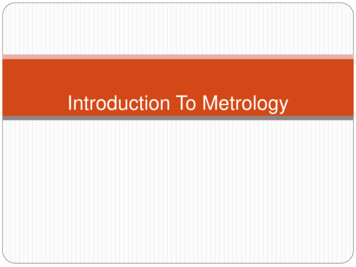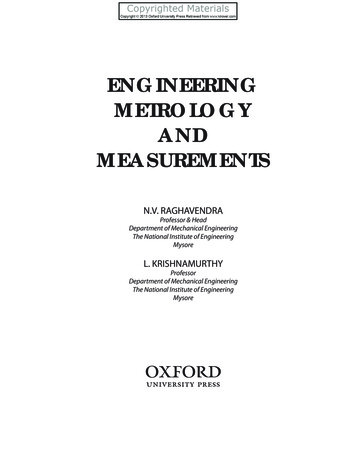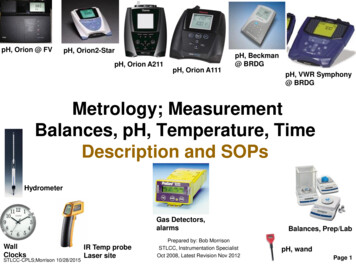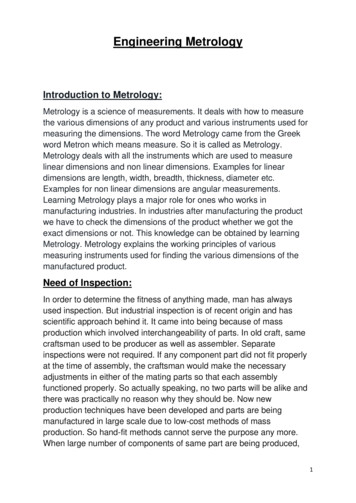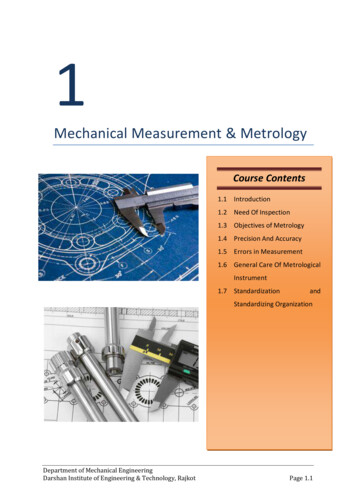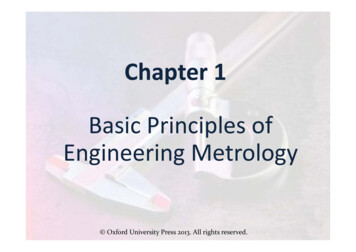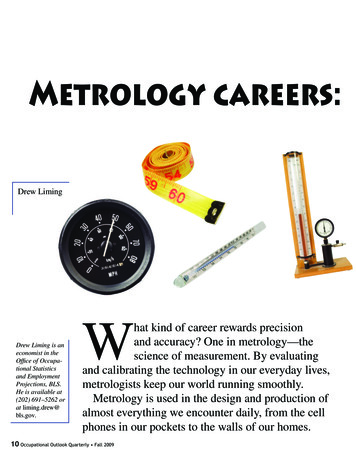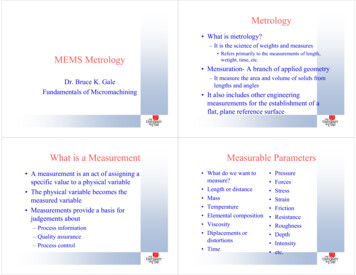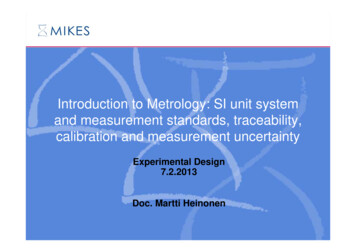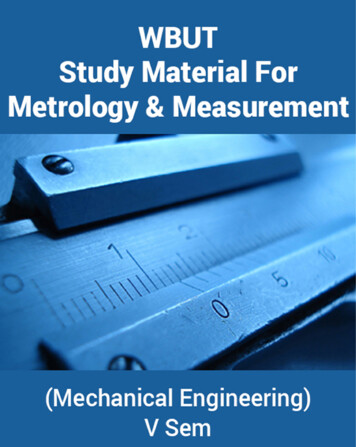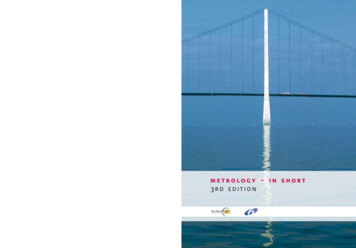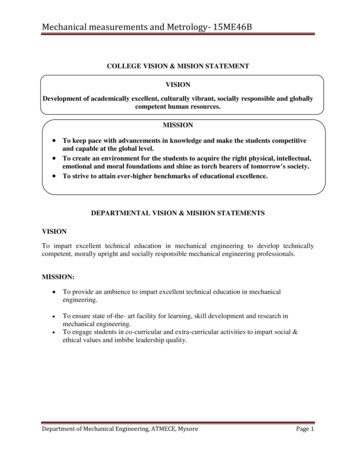
Transcription
Mechanical measurements and Metrology- 15ME46BCOLLEGE VISION & MISION STATEMENTVISIONDevelopment of academically excellent, culturally vibrant, socially responsible and globallycompetent human resources.MISSION To keep pace with advancements in knowledge and make the students competitiveand capable at the global level. To create an environment for the students to acquire the right physical, intellectual,emotional and moral foundations and shine as torch bearers of tomorrow's society. To strive to attain ever-higher benchmarks of educational excellence.DEPARTMENTAL VISION & MISIION STATEMENTSVISIONTo impart excellent technical education in mechanical engineering to develop technicallycompetent, morally upright and socially responsible mechanical engineering professionals.MISSION: To provide an ambience to impart excellent technical education in mechanicalengineering. To ensure state of-the- art facility for learning, skill development and research inmechanical engineering.To engage students in co-curricular and extra-curricular activities to impart social ðical values and imbibe leadership quality. Department of Mechanical Engineering, ATMECE, MysorePage 1
Mechanical measurements and Metrology- 15ME46BPROGRAM EDUCATIONAL OBJECTIVES (PEO’S)After successful completion of program, the graduates will bePEO 1: Graduates will be able to have successful professional career in the allied areasand be proficient to perceive higher education.PEO 2: Graduates will attain the technical ability to understand the need analysis, design,manufacturing, quality changing and analysis of the product.PEO 3: Work effectively, ethically and socially responsible in allied fields of mechanicalengineering.PEO 4: Work in a team to meet personal and organizational objectives and to contributeto the development of the society in large.PROGRAM OUTCOMES (PO’S)The Mechanical engineering program students will attain:PO1. Engineering knowledge: Apply the knowledge of mathematics, science, engineeringfundamentals, and an engineering specialization to the solution of complex engineeringproblemsPO2. Problem analysis: Identify, formulate, research literature, and analyze complexengineering problems reaching substantiated conclusions using first principles ofmathematics, natural sciences, and engineering sciencesPO3. Design/development of solutions: Design solutions for complex engineering problemsand design system components or processes that meet the specified needs withappropriate consideration for the public health and safety, and the cultural, societal, andenvironmental considerationsPO4. Conduct investigations of complex problems: Use research-based knowledge andresearch methods including design of experiments, analysis and interpretation of data,and synthesis of the information to provide valid conclusionsPO5. Modern tool usage: Create, select, and apply appropriate techniques, resources, andmodern engineering and IT tools including prediction and modeling to complexengineering activities with an understanding of the limitationsPO6. The engineer and society: Apply reasoning informed by the contextual knowledge toassess societal, health, safety, legal and cultural issues and the consequent responsibilitiesrelevant to the professional engineering practiceDepartment of Mechanical Engineering, ATMECE, MysorePage 2
Mechanical measurements and Metrology- 15ME46BPO7. Environment and sustainability: Understand the impact of the professionalengineering solutions in societal and environmental contexts, and demonstrate theknowledge of, and need for sustainable developmentPO8. Ethics: Apply ethical principles and commit to professional ethics and responsibilitiesand norms of the engineering practicePO9. Individual and team work: Function effectively as an individual, and as a member orleader in diverse teams, and in multidisciplinary settingsPO10.Communication: Communicate effectively on complex engineering activities with theengineering community and with society at large, such as, being able to comprehend andwrite effective reports and design documentation, make effective presentations, and giveand receive clear instructionsPO11.Project management and finance: Demonstrate knowledge and understanding of theengineering and management principles and apply these to one’s own work, as amember and leader in a team, to manage projects and in multidisciplinary environmentsPO12.Life-long learning: Recognize the need for, and have the preparation and ability toengage in independent and life-long learning in the broadest context of technologicalchangePROGRAM SPECIFIC OUTCOMES (PSO’S)After successful completion of program, the graduates will bePSO 1: To comprehend the knowledge of mechanical engineering and apply them toidentify, formulate and address the mechanical engineering problems using latesttechnology in a effective manner.PSO 2: To work successfully as a mechanical engineer in team, exhibit leadership qualityand provide viable solution to industrial and societal problems.PSO 3: To apply modern management techniques and manufacturing techniques toproduce products of high quality at optimal cost.PSO 4: To exhibit honesty, integrity, and conduct oneself responsibly, ethically andlegally, holding the safety and welfare of the society paramount.Department of Mechanical Engineering, ATMECE, MysorePage 3
Mechanical measurements and Metrology- 15ME46BContentsModule 1: Introduction to Metrology, Linear Measurement and angular measurementsModule 2: System of Limits, Fits, Tolerance and Gauging, ComparatorsModule 3: Measurement of screw thread and gear, Advances in metrologyModule 4: Measurement systems and basic concepts of measurement methods, Intermediatemodifying and terminating devicesModule 5: Force, Torque and Pressure Measurement , Measurement of strain and temperatureDepartment of Mechanical Engineering, ATMECE, MysorePage 4
Mechanical measurements and Metrology- 15ME46BMODULE 11.11.21.31.4Introduction to Metrology:1.1.1Definition,1.1.2objectives and concept of metrology,1.1.3Need of inspection, Principles, process,1.1.4methods of measurement,Classification and selection of measuring instruments and systems.1.2.1Accuracy,1.2.2precision1.2.3errors in measurement.System of measurement,1.3.1Material Standard,1.3.2Wavelength Standards,1.3.3Subdivision of standards1.3.4, Line and End standards1.3.5, Classification of standards and Traceability,1.3.6calibration of End bars(Numericals), standardization.Linear Measurement and angular measurements:1.4.1Slip gauges- Indian standards on slip gauge,1.4.2method of selection of slip gauge, stack of slip gauge,1.4.3adjustable slip gauge, wringing of slip gauge, care of slip gauge, slip gaugeaccessories,1.5problems on building of slip gauges (M87, M112).1.6Measurement of angles- sine bar, sine center, angle gauges,1.7optical instruments for angular measurements,1.8Auto collimator-applications for measuring straightness and squarenesDepartment of Mechanical Engineering, ATMECE, MysorePage 5
Mechanical measurements and Metrology- 15ME46B1.1Introduction to Metrology:1.1.1Definition,Metrology [from Ancient Greek metron (measure) and logos (study of)] is the science ofmeasurement. Metrology includes all theoretical and practical aspects of measurement.Metrology is concerned with the establishment, reproduction, conservation and transferof units of measurement & their standards.For engineering purposes, metrology is restricted to measurements of length and angle &quantities which are expressed in linear or angular terms. Measurement is a process ofcomparing quantitatively an unknown magnitude with a predefined standard.1.1.2objectives and concept of metrology,The basic objectives of metrology are;1. To provide accuracy at minimum cost.2. Thorough evaluation of newly developed products, and to ensure that components are withinthe specified dimensions.3. To determine the process capabilities.4. To assess the measuring instrument capabilities and ensure that they are adequate for theirspecific measurements.5. To reduce the cost of inspection & rejections and rework.6. To standardize measuring methods.7. To maintain the accuracy of measurements through periodical calibration of the instruments.8. To prepare designs for gauges and special inspection fixtures.1.1.3 Need of inspection, Principles, process,In order to determine the fitness of anything made, man has always used inspection. Butindustrial inspection is of recent origin and has scientific approach behind it. It came into beingbecause of mass production which involved interchangeability of parts. In old craft, samecraftsman used to be producer as well as assembler. Separate inspections were not required. Ifany component part did not fit properly at the time of assembly, the craftsman would make thenecessary adjustments in either of the mating parts so that each assembly functioned properly. Soactually speaking, no two parts will be alike/and there was practically no reason why they shouldbe. Now new production techniques have been developed and parts are being manufactured inDepartment of Mechanical Engineering, ATMECE, MysorePage 6
Mechanical measurements and Metrology- 15ME46Blarge scale due to low-cost methods of mass production. So hand-fit methods cannot serve thepurpose any more. When large number of components of same part is being produced, then anypart would be required to fit properly into any other mating component part. This requiredspecialisation of men and machines for the performance of certain operations. It has, therefore,been considered necessary to divorce the worker from all round crafts work and to supplanthand-fit methods with interchangeable manufacture. The modern production techniques requirethat production of complete article be broken up into various component parts so that theproduction of each component part becomes an independent process. The various parts to beassembled together in assembly shop come from various shops. Rather some parts aremanufactured in other factories also and then assembled at one place. So it is very essential thatparts must be so fabricated that the satisfactory mating of any pair chosen at random is possible.In order that this may be possible, the dimensions of the component part must be confined withinthe prescribed limits which are such as to permit the assembly with a predetermined fit. Thusindustrial inspection assumed its importance due to necessity of suitable mating of variouscomponents manufactured separately. It may be appreciated that when large quantities of workpieces are manufactured on the basis of interchangeability, it is not necessary to actually measurethe important features and much time could be saved by using gauges which determine whetheror not a particular feature is within the prescribed limits. The methods of gauging, therefore,determine the dimensional accuracy of a feature, without reference to its actual size.The purpose of dimensional control is however not to strive for the exact size as it is impossibleto produce all the parts of exactly same size due to so many inherent and random sources oferrors in machines and men. The principal aim is to control and restrict the variations within theprescribed limits. Since we are interested in producing the parts such that assembly meets theprescribed work standard, we must not aim at accuracy beyond the set limits which, otherwise islikely to lead to wastage of time and uneconomical results. Lastly, inspection led to developmentof precision inspection instruments which caused the transition from crude machines to betterdesigned and precision machines. It had also led to improvements in metallurgy and raw materialmanufacturing due to demands of high accuracy and precision. Inspection has also introduced ducts in volume by eliminating tooling bottle-necks and better processing techniques.Department of Mechanical Engineering, ATMECE, MysorePage 7
Mechanical measurements and Metrology- 15ME46B1.1.4methods of measurement,Two basic methods are commonly employed for measurement.(a) Direct comparison with primary or secondary standard.(b) Indirect comparison through the use of calibrated system.Direct comparisonIn this method, measurement is made directly by comparing the unknown magnitude witha standard & the result is expressed by a number. The simplest example for this would be, lengthmeasurement using a meter scale. Here we compare the bar’s length (unknown quantity/ measureand) with a scale (Standard/predefined one). We say that the bar measures so many mms, cms orinches in length. Direct comparison methods are quite common for measurement of physical quantitieslike length, mass, etc. It is easy and quick.Drawbacks of Direct comparison methods The main drawback of this method is, the method is not always accurate and reliable. Also, human senses are not equipped to make direct comparison of all quantities withequal facility all the times. Also measurements by direct methods are not always possible, feasible and practicable.Example: Measurement of temperature, Measurement of weight.Indirect comparison Most of the measurement systems use indirect method of measurement. In this method a chain of devices which is together called as measuring system is employed. The chain of devices transform the sensed signal into a more convenient form & indicate thistransformed signal either on an indicator or a recorder or fed to a controller. i.e. it makes use of a transducing device/element which convert the basic form of input into ananalogous form, which it then processes and presents as a known function of input. For example, to measure strain in a machine member, a component senses the strain, anothercomponent transforms the sensed signal into an electrical quantity which is then processedsuitably before being fed to a meter or recorder. Further, human senses are not equipped to detect quantities like pressure, force or strain. But can feel or sense and cannot predict the exact magnitude of such quantities.Department of Mechanical Engineering, ATMECE, MysorePage 8
Mechanical measurements and Metrology- 15ME46B Hence, we require a system that detects/sense, converts and finally presents the output in theform of a displacement of a pointer over a scale a , a change in resistance or raise in liquid levelwith respect to a graduated stem.1.2Classification and selection of measuring instruments and systems.Measurements are generally made by indirect comparison method through calibration.They usually make use of one or more transducing device. Based upon the complexity ofmeasurement system, three basic categories of measurements have been developed.They are;1. Primary measurement2. Secondary measurement3. Tertiary measurementPrimary measurementIn primary mode, the sought value of a physical parameter is determined by comparing itdirectly with reference standards. The requisite information is obtainable through senses of sightand touch.Example: matching of two lengths when determining the length of an object with a ruler.Secondary measurementThe indirect measurements involving one translation are called secondary measurements.Example: the conversion of pressure into displacement by bellows.Department of Mechanical Engineering, ATMECE, MysorePage 9
Mechanical measurements and Metrology- 15ME46BTertiary measurementThe indirect measurements involving two conversions are called tertiary measurements.Example: the measurement of the speed of a rotating shaft by means of an electric tachometer.1.2.1Accuracy,The accuracy of an instrument indicates the deviation of the reading from a known input.In other words, accuracy is the closeness with which the readings of an instrument approachesthe true values of the quantity measured. It is the maximum amount by which the result differsfrom the true value.Accuracy is expressed as a percentage based on the actual scale reading / full scalereading.Percentage accuracy based on reading [Vr(max or min) –Va]*100/VaPercentage accuracy (based on full scale reading) ((Va Actual valueVr max or min result value.Vfs full scale readingExample: 100 bar pressure gauge having an accuracy of 1% would be accurate within /-1 barover the entire range of gauge.1.2.2 precisionThe precision of an instrument indicates its ability to reproduce a certain reading witha given accuracy. In other words, it is the degree of agreement between repeated results.Department of Mechanical Engineering, ATMECE, MysorePage 10
Mechanical measurements and Metrology- 15ME46B1.2.3 errors in measurement.Error may be defined as the difference between the measured value and the true value.Error classificationClassified in different ways Systematic error Random errors Illegitimate errorsSystematic errors Generally the will be constant / similar form /recur consistently every timemeasurement is measured. May result from improper condition or procedures employed.Calibration errorsCalibration procedure-is employed in a number of instruments-act of checking oradjusting the accuracy of a measuring instrument.Human errors The term “human error” is often used very loosely. We assume that when we use it, everyone will understand what it means. But that understanding may not be same as what the person meant in using the term. For this reason, without a universally accepted definition, use of such terms is subject tomisinterpretation.(1) Systematic or fixed errors:(a) Calibration errors(b) Certain types of consistently recurring human errors(c) Errors of technique(d) Uncorrected loading errors(e) Limits of system resolution Systematic errors are repetitive & of fixed value. Theyhave a definite magnitude & direction(2) Random or Accidental errors:(a) Errors stemming from environmental variations(b) Certain types of human errorsDepartment of Mechanical Engineering, ATMECE, MysorePage 11
Mechanical measurements and Metrology- 15ME46B(c) Due to Variations in definition(d) Due to Insufficient sensitivity of measuring system.Random errors are distinguishable by their lack of consistency. An observer may not beconsistent in taking readings. Also the process involved may include certain poorly controlledvariables causing changing conditions. The variations in temperature, vibrations of externalmedium, etc. cause errors in the instrument. Errors of this type are normally of limited duration& are inherent to specific environment.(3) Illegitimate errors:(a) Blunders or Mistakes(b) Computational errors(c) Chaotic errors1.3System of measurement,Definition of StandardsA standard is defined as “something that is set up and established by an authority as ruleof the measure of quantity, weight, extent, value or quality”.For example: a meter is a standard established by an international organization for measurementof length. Industry, commerce, international trade in modern civilization would be impossiblewithout a good system of standards.Role of StandardsThe role of standards is to achieve uniform, consistent and repeatable measurementsthroughout the world. Today our entire industrial economy is based on the interchangeability ofparts the method of manufacture. To achieve this, a measuring system adequate to define thefeatures to the accuracy required & the standards of sufficient accuracy to support the measuringsystem are necessary.1.3.1 Material Standard,In practice, the accurate measurement must be made by comparison with a standard ofknown dimension and such a standard is called “Primary Standard”. The first accurate standardwas made in England and was known as “Imperial Standard yard” which was followed byDepartment of Mechanical Engineering, ATMECE, MysorePage 12
Mechanical measurements and Metrology- 15ME46BInternational Prototype meter” made in France. Since these two standards of length were made ofmetal alloys they are called ‘material length standards’.International Prototype meterIt is defined as the straight line distance, at 0 C, between the engraved lines of pureplatinum-iridium alloy (90% platinum & 10% iridium) of 1020 mm total length and having a‘tresca’ cross section as shown in fig. The graduations are on the upper surface of the web whichcoincides with the neutral axis of the section.The tresca cross section gives greater rigidity for the amount of material involved and istherefore economic in the use of an expensive metal. The platinum-iridium alloy is used becauseit is non oxidizable and retains good polished surface required for engraving good quality lines.Imperial Standard yardAn imperial standard yard, shown in fig, is a bronze (82% Cu, 13% tin, 5% Zinc) bar of 1inch square section and 38 inches long. A round recess, 1 inch away from the two ends is cut atboth ends upto the central or ‘neutral plane’ of the bar.Further, a small round recess of (1/10) inch in diameter is made below the center. Twogold plugs of (1/10) inch diameter having engravings are inserted into these holes so that thelines (engravings) are in neutral plane.Yard is defined as the distance between the two central transverse lines of the gold plugat 620F.Department of Mechanical Engineering, ATMECE, MysorePage 13
Mechanical measurements and Metrology- 15ME46BThe purpose of keeping the gold plugs in line with the neutral axis is to ensure that theneutral axis remains unaffected due to bending, and to protect the gold plugs from accidentaldamage.Bronze Yard was the official standard of length for the United States between 1855 and1892, when the US went to metric standards. 1 yard 0.9144 meter. The yard is used as thestandard unit of field-length measurement in American, Canadian and Association football,cricket pitch dimensions, swimming pools, and in some countries, golf fairway measurements.Disadvantages of Material length standards1. Material length standards vary in length over the years owing to molecular changes inthe alloy.2. The exact replicas of material length standards were not available for use somewhereelse.3. If these standards are accidentally damaged or destroyed then exact copies could not bemade.4. Conversion factors have to be used for changing over to metric system.1.3.2 Wavelength Standards,Department of Mechanical Engineering, ATMECE, MysorePage 14
Mechanical measurements and Metrology- 15ME46BBecause of the problems of variation in length of material length standards, thepossibility of using light as a basic unit to define primary standard has been considered. Thewavelength of a selected radiation of light and is used as the basic unit of length. Since thewavelength is not a physical one, it need not be preserved & can be easily reproducible withoutconsiderable error.A krypton-filled discharge tube in the shape of the element's atomic symbol. A colorless,odorless, tasteless noble gas, krypton occurs in trace amounts in the atmosphere, is isolated byfractionally distilling liquefied air. The high power and relative ease of operation of kryptondischarge tubes caused (from 1960 to 1983) the official meter to be defined in terms of oneorange-red spectral line of krypton-86.Advantages of using wave length standards1. Length does not change.2. It can be easily reproduced easily if destroyed.3. This primary unit is easily accessible to any physical laboratories.4. It can be used for making measurements with much higher accuracy than material standards.5. Wavelength standard can be reproduced consistently at any time and at any place.Subdivision of standardsThe imperial standard yard and the international prototype meter are master standards &cannot be used for ordinary purposes. Thus based upon the accuracy required, the standards aresubdivided into four grades namely;1. Primary Standards2. Secondary standards3. Teritiary standardsDepartment of Mechanical Engineering, ATMECE, MysorePage 15
Mechanical measurements and Metrology- 15ME46B4. Working standardsPrimary standardsThey are material standard preserved under most careful conditions. These are not usedfor directly for measurements but are used once in 10 or 20 years for calibrating secondarystandards. Ex: International Prototype meter, Imperial Standard yard.Secondary standardsThese are close copies of primary standards w.r.t design, material & length. Any errorexisting in these standards is recorded by comparison with primary standards after long intervals.They are kept at a number of places under great supervision and serve as reference for tertiarystandards. This also acts as safeguard against the loss or destruction of primary standards.Teritiary standardsThe primary or secondary standards exist as the ultimate controls for reference at rareintervals. Tertiary standards are the reference standards employed by National Physicallaboratory (N.P.L) and are the first standards to be used for reference in laboratories &workshops. They are made as close copies of secondary standards & are kept as reference forcomparison with working standards.Working standardsThese standards are similar in design to primary, secondary & tertiary standards. Butbeing less in cost and are made of low grade materials, they are used for general applications inmetrology laboratories.Sometimes, standards are also classified as; Reference standards (used as reference purposes) Calibration standards (used for calibration of inspection & working standards) Inspection standards (used by inspectors) Working standards (used by operators)1.3.3 Subdivision of standardsWhen the length being measured is expressed as the distance between two lines, then it iscalled “Line Standard”.Department of Mechanical Engineering, ATMECE, MysorePage 16
Mechanical measurements and Metrology- 15ME46BExamples: Measuring scales, Imperial standard yard, International prototype meter, etc.1.3.4 ,Line and End standardsCharacteristics of Line Standards1. Scales can be accurately engraved but it is difficult to take the full advantage of this accuracy.Ex: A steel rule can be read to about 0.2 mm of true dimension.2. A scale is quick and easy to use over a wide range of measurements.3. The wear on the leading ends results in ‘under sizing’4. A scale does not possess a ‘built in’ datum which would allow easy scale alignment with theaxis of measurement, this again results in ‘under sizing’.5. Scales are subjected to parallax effect, which is a source of both positive & negative readingerrors6. Scales are not convenient for close tolerance length measurements except in conjunction withmicroscopes.END STANDARDSWhen the length being measured is expressed as the distance between two parallel faces,then it is called ‘End standard’. End standards can be made to a very high degree of accuracy.Ex: Slip gauges, Gap gauges, Ends of micrometer anvils, etc.Characteristics of End Standards1. End standards are highly accurate and are well suited for measurements of close tolerances assmall as 0.0005 mm.2. They are time consuming in use and prove only one dimension at a time.3. End standards are subjected to wear on their measuring faces.4. End standards have a ‘built in’ datum, because their measuring faces are flat & parallel andcan be positively located on a datum surface.5. They are not subjected to the parallax effect since their use depends on “feel”.6. Groups of blocks may be “wrung” together to build up any length. But faulty wringing leadsto damage.7. The accuracy of both end & line standards are affected by temperature change.Department of Mechanical Engineering, ATMECE, MysorePage 17
Mechanical measurements and Metrology- 15ME46B1.3.5 calibration of End bars(Numericals), standardization.The actual lengths of end bars can be found by wringing them together and comparingthem with a calibrated standard using a level comparator and also individually comparing amongthemselves. This helps to set up a system of linear equations which can be solved to find theactual lengths of individual bars. The procedure is clearly explained in the forthcomingnumerical problems.Numerical problem-1Three 100 mm end bars are measured on a level comparator by first wringing them together andcomparing with a calibrated 300 mm bar which has a known error of 40mm. The three end barstogether measure 64 m m less than the 300 mm bar. Bar A is 18 mm longer than bar B and23mm longer than bar C. Find the actual length of each bar.Department of Mechanical Engineering, ATMECE, MysorePage 18
Mechanical measurements and Metrology- 15ME46BNumerical problem-2Four end bars of basic length 100 mm are to be calibrated using a standard bar of 400 mm whoseactual length is 399.9992 mm. It was also found that lengths of bars B,C & D in comparison withA are 0.0002 mm, 0.0004 mm and -0.0001 mm respectively and the length of all the four barsput together in comparison with the standard bar is 0.0003mm longer. Determine the actuallengths of each end bars.1.4Linear Measurement and angular measurements:1.4.1Slip gauges- Indian standards on slip gauge,SLIP GAUGES OR GAUGE BLOCKS (JOHANSSON GAUGES)Slip gauges are rectangular blocks of steel having cross section of 30 mm face length &10 mm face width as shown in fig.Department of Mechanical Engineering, ATMECE, MysorePage 19
Mechanical measurements and Metrology- 15ME46BSlip gauges are blocks of steel that have been hardened and stabilized byheat treatment. They are ground and lapped to size to very high standards ofaccuracy and surface finish. A gauge block (also known Johansson gauge, slipgauge, or Jo block) is a precision length measuring standard consisting of a groundand lapped metal or ceramic block. Slip gauges were invented in 1896 by Swedishmachinist Carl Edward Johansson.Manufacture of Slip GaugesDepartment of Mechanical Engineering, ATMECE, MysorePage 20
Mechanical measurements and Metrology- 15ME46BWhen correctly cleaned and wrung together, the individual slip gauges adhere to eachother by molecular attraction and, if
Mechanical measurements and Metrology- 15ME46B Department of Mechanical Engineering, ATMECE, Mysore Page 6 1.1 Introduction to Metrology: 1.1.1 Definition, Metrology [from Ancient Greek metron (measure) and logos (study of)] is the science of measurement. Metrology inclu
